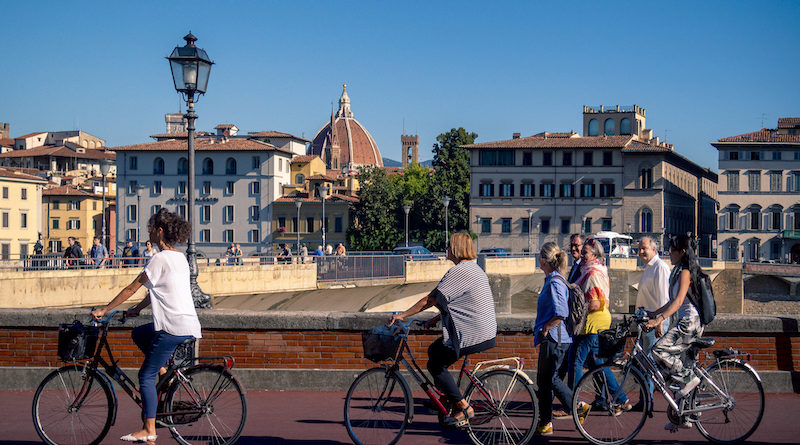
Better mobility, better city, better life
As the place where most people live, and where most emissions are produced, the engagement of urban municipalities is paramount to successfully addressing climate change.
Mobility, including public transport, stands out as one of the most powerful instruments to introduce environmentally-friendly measures and to improve city residents’ wellbeing, health and living conditions.
In fact, it’s an area where a lot is already being done. Cities are promoting cycling and walking, offering shared e-mobility services, greening public transport solutions and introducing pedestrian areas and car-free zones, making better use of the public space.
Improving air quality literally brings visible results, and in London, for instance, where the local authority has recently extended the ultra-low emission zone, drivers are getting rid of diesel cars six times faster than in the rest of the UK.
In my city, Florence, we have developed a “green shield” – a large Low Emission Zone, which aims to regulate the access of the most polluting vehicles into the city, including by encouraging the use of public transport and bans on certain vehicles.
With COP26 only a few weeks behind us, sharing and strengthening successful models like this is how international goals will be achieved in practice.
In September we marked the 20th anniversary of European Mobility Week, which helps people to become more conscious of their mobility-related carbon footprint. Culminating, as it does every year with car-free day, the 2021 campaign to promote sustainable and active mobility focused on health.
Despite such efforts, 74% of urban inhabitants are still exposed to harmful air pollutants at concentration levels above the recommended World Health Organisation guidelines.
This is not where we should be – urban transport is still a major source of air pollution and the only sector where greenhouse gases haven’t decreased in the past decade.
This situation has to change: in a recent Eurocities position paper – the cities network of which I am President – we called for a full stop on fossil-fuelled mobility in cities through actions such as an accelerated switch to zero-emission mobility and by phasing out new fossil-fuelled vehicle sales in the EU by 2035. While actions like these will not lead to overnight change, they will nonetheless be vital to achieving climate neutrality by mid-century
Getting smarter on mobility
I believe public transport should be put at the heart of sustainable urban mobility planning. In Florence, after having put three tram lines into operation, serving around 38 million annual passengers, we are currently creating a fourth line, and linking to neighbouring municipalities.
Moreover, we’re completing around 10 km of new cycle paths, meaning that by 2024 we’ll have around 120 km in total. We’ve also deployed 3,000 bikes, of which 1,000 are e-bikes, adding to our public service offer, and have constructed other cycling specific infrastructure, such as cycle bridges.
Shared, connected and automated shuttles and robotaxis are the next step, the new frontier of mobility, and are one of the developing trends in the urban mobility landscape and can ultimately work in tandem with the current public transport infrastructure, if the right conditions are set.
Smart mobility promises to bring benefits such as a reduction in car trips. However, on the downside, it also threatens to disrupt local transport systems, challenge existing traffic regulations, and generate unintended societal and environmental changes.
To be effective, all automated mobility innovations will need to face a real-life test in specific urban contexts. This is why I believe that, looking ahead, it will be crucial to ensure that automated transport services can be deployed safely and sustainably, if they are to provide concrete benefits for cities and their residents.
Beyond smart vehicles, the boom in e-commerce in recent years has also led to new tests for cities, mainly driven by a noticeable increase in the transport of goods. Some projections show that the growing demand for e-commerce will result in 36% more delivery vehicles in inner cities by 2030.
Already, local officials are coming up with solutions: Stuttgart, for example, is researching and supporting alternatives to conventional delivery solutions to cope with this growing demand. Rotterdam, on the other hand, will use fully electric vans from 2025.
I am convinced that cities are perfectly able to stand up to e-commerce’s challenges but they won’t be able to go it alone, without help from the EU to set, for instance, the right conditions for the supply of zero-emission vans or to deploy recharging and refuelling points.
International efforts
Local governments need the tools to ensure that public transport is accessible, attractive, affordable for all citizens and can survive unpredictable challenges.
Many urban public transport systems have suffered a decline in passenger numbers, and therefore revenue, throughout the Covid19 pandemic. As a result, many cities are reassessing how public transport can be financially sustainable in the long-term.
At the same time, cities are international transport hubs. As such, we need to constantly work at different levels and with different partners to ensure the viability of our mobility systems. That’s why we’re asking for further EU support – for example to provide local officials with the tools to integrate long-haul transport into urban mobility planning – and for other actors in the mobility field to work closer with city governments by, for example, increasing our representation in the governance of major connective infrastructures on our territories, such as airports and depots.
Ultimately, this is valid for all other aspects of urban sustainable mobility: only through a concerted approach and through the cooperation of national and EU authorities will cities be able to introduce safer, more sustainable and affordable mobility models.
We can only succeed when cities are on board, when local leaders have a seat at the table where decisions are made. International action is absolutely vital for cities because so often we are the ones that translate words into action.




